February 21st, 2012
| 3 Comments »

This boy of mine, a man-child with the deep voice and winsome smile, self-sufficient and capable who is learning to drive and manage a bank account and negotiate girls and friendships….. so much that’s happening with him on every passing day but he can’t seem to manage taking a shower without a few heavy knocks on the door.
And on occasion, shutting off the hot water and giving him ‘The Big Chill’.
As battles go, I know this one is pretty low on the priority scale. When we say ‘Be home by midnight’ he’s usually walking in the door around 11:30. When he has a sleepover with his friends, the worst thing they do is consume too much junk food and pop.
He makes his own breakfast and lunch. When we ask for him to manage dinner, he makes us a feast. If I leave him a task list before I go to work, it’s complete by the time I come home. He still likes to hang out with us, watching a movie or TV show. He washes his own clothes without our prompting, he willingly goes to church, he loves to read and he enjoys good friendships with his band of brothers from his Youth Group, and with his cousins.
But, he still needs ‘The Big Chill’.
He’s not sneaking out of the house after we’re asleep, to meet friends who encourage illicit activities. He’s not coming home from hanging out with his pals sporting telltale signs of substance abuse or alcohol consumption. He’s not stealthily smoking cigarettes, chasing after all kinds of girls, committing vandalism, TP-ing houses, terrorizing neighbors. We trust his friends, and that goes far. If the worst offense he encounters away from the protection of our wings is a trip to Chipotle after his rec league basketball game, then I consider us pretty darn lucky.
Then come those morning, and we have to flip that knob that cuts the flow of hot water, because the knock at the door and the responding ‘Ok.’ haven’t made a bit of difference.
He turns 18 in April, and yet, in no way in this man-child an adult. Maybe in some ancient time, when life was far different and everyone needed to be so much more self-sufficient, and when the life expectancy was more like 30, when we didn’t have the ability to thrive in to our 80’s or higher, when the dangers of life could take their toll far quicker and more exacting, maybe then 18 was adulthood, worthy of responsibility, of letting go and watching them spread their own wings to fly. Used to be that a girl of 18 who was unmarried was considered too old. A time existed that man of 18 had all the markings of adulthood; a wife, a homestead and his own team of horses. But this isn’t the case now.
And that’s all right with me. I wasn’t ready to fly by myself either at that age. And although he moves closer to finding his own freedom every day, and we plot to move him in the right direction, he still has moments where he sits down by me, just wanting my proximity. He still loves it when I grab him in a huge hug, and hold on tight. He can figure out his future, take stock of what he wants from it and try to make it all work out and I can sit back and enjoy the process of seeing him test those wings, listening and supporting his ideas. I find a few things to tease him about, but it’s a huge stretch to do so, because this boy of mine, for all those moments of forgetfulness, when he doesn’t recall the task list I left or simply decides he doesn’t want to do what we ask, well those are few and far between. And as parenting a teenager goes, it’s an awfully good thing going on here, worthy of the pride it evokes.
If my only vice with him is that he is soothed by a long, hot shower in the morning, then I’ve got little to complain about.
 {{Just Write 23}} is happening, over at The Extraordinary Ordinary. {{Just Write 23}} is happening, over at The Extraordinary Ordinary.
Won’t you head over there and read some of the other posts??
February 18th, 2012
| 2 Comments »
I’ve been paying attention to all things food for as far back as I can recall, and the more in-depth I go with food, in all aspects of my life, the more I can see over my lifetime that it’s been in me since I was just a little kid.
Back in the early years of college, I used to randomly read Cosmopolitan magazine, long before it became the sensationalist rag that it is today. On one occasion, while sitting in the student union at the U of M, waiting for a perpetually late friend to show up for a study date, I picked up a ragged and torn issue of Cosmopolitan and began paging through it. I came across an article about using regular, ordinary food products for beauty treatments, and read through it, transfixed. Here was simple and easy ways to enhance the look and feel of your skin, using items that everyone has at their fingertips. I slipped the magazine in my backpack, and those pages became so dog-eared from use that I eventually tossed them out. But the information I read there, and keep in mind that this was likely in 1983 or 1984, I have utilized in some way, to this day. And it’s been illuminating to see the food world around me embrace the use of everyday food items for personal use.
The best part about these treatments is that they are completely chemical-free. No worries about absorbing something unsafe into your body, and you aren’t harming the environment when you rinse them down the drain.
Here’s a few of the treatments that I love:
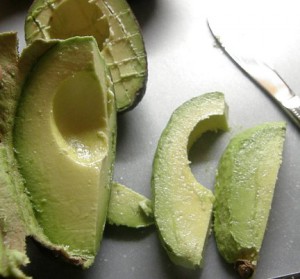
Avocado Hair Mask: Mash one ripe avocado in a bowl with a few teaspoons of olive oil. Apply to slightly damp hair (prior to washing) Rub or comb through and place a plastic bag over your hair to insulate. Wrap your head in a towel and let the treatment sit for an hour. Wash hair as usual. Avocado oil is also good to have on hand. Rub a few drops through your hair after styling to help tame flyaways and make it feel lustrous.
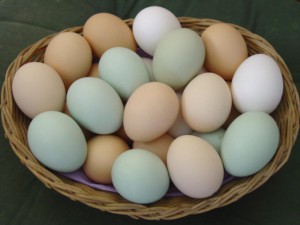
Egg White Skin Toner: Whip an egg white until stiff peaks form. With your fingertips, apply the whites to your freshly washed face. It’s messy, yes; but after a half hour or so when you rinse it off, your skin will feel tight and firm, and man alive, will it glow!! The proteins in egg whites will do wonders for your skin, as well as your eating plan. This can be used on any part of your body.
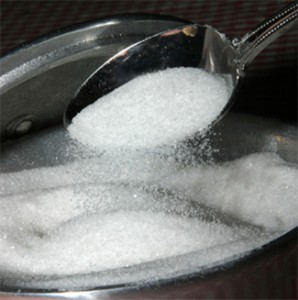
Sugar Scrubs: These are very popular now, but I’ve been using some form of a sugar scrub for a very long time. Mix a cup of plain white sugar with a few tablespoons of olive, avocado or almond oil and several drops of any essential oil you like (my favorite is bergamot oil- smells like oranges, or lavender). Mix to combine and keep in a sealed jar. Scoop a small amount on wet hands and rub sugar over skin, nail beds and cuticles. Rinse with warm water and apply a good moisturizer. This can be used all over the body for amazing exfoliation. Mix 1/4 cup of coarse cornmeal in with the sugar and oils to use on tougher areas, like feet and elbows. My friend Shaina has a lovely recipe on her blog for Ginger and Coconut Oil Sugar Body Scrub that sounds amazing.

Olive Oil Wash: Olive oil was once prized by ancient civilizations for it’s moisturizing properties, long before it became a staple in cooking. When I worked in a professional kitchen and washed my hands a million times in my 8-hour shift, I would drizzle a bit of olive oil on them to help keep them from cracking and drying out, as it wouldn’t contaminate the food I was preparing like regular lotion. A dime-sized amount in the palm of your hands make a refreshing and pure face wash, lifting dirt and oil gently and without harsh chemicals. Your skin feels incredibly soft and clean. I realize it sounds counterintuitive, but it really works.
Olive oil is also an excellent source of moisture in your hair. As a pre-shampoo treatment, rub it through the ends of your dry hair, then massage a bit on your scalp. Cover your head with plastic and allow it to sit for 15-20 minutes before you shampoo and condition as usual. If you use a deep conditioner on your hair, you can add a few drops of olive oil to it before applying for an extra level of moisturizing. {{For more information and ideas: source: Hairlicious}}

Almond Facial Scrub: It helps the look of your skin to exfoliate the dead layers on a regular basis. Crushed almonds make for an amazing facial scrub. Grind the nuts to a coarse powder; add a bit of water and gently rub the mixture over your face, avoiding the tender skin around the eyes. I love how this smooths out rough patches on my forehead, and really cleans up the pores. Coarsely ground oatmeal is also an excellent exfoliator, and is a bit more gentle for sensitive skin.
Almonds are a nutrient powerhouse for the entire body, and one food item worth incorporating in to your eating.

Apple Cider Vinegar: The astringent properties of apple cider vinegar are wonderful for neutralizing minor skin irritations and helping calm the aggravation of yeast infections. A cup of this in a shallow bath is very soothing, and you can dab it on mosquito bites to take the itch away. A cotton swab dipped in apple cider vinegar and touched to acne breakouts can help speed the healing process.
Check out Bragg Live Foods for more information on the benefits of Apple Cider Vinegar.

Baking Soda Build-Up Remover: As someone who has colored her hair for most of my life, this method for removing build-up on my hair has been the best overall natural treatment I’ve done. If you use any kind of styling products on your hair like gels or sprays, they can build up over time and cause hair to become limp and dull. I can’t use shampoos that will do this, as they strip the color right out of my hair, making it really flat. But adding a tablespoon of baking soda to my shampoo creates a natural cleanse that leaves my hair shiny and fresh, and most importantly, with the color intact. Keep a box within reach of your shower and add a small amount to your shampoo weekly for best results. It will leave the hair shaft wide open, and your hair might feel a bit rough when you rinse but a good deep conditioner follow-up will take care of that right away. You’ll love how it feels.
Baking soda is a mighty multi-tasker in your household, as many of you know how well it works for cleaning purposes too. Here’s a good article on the versatility of this pantry standard: “51 Fantastic Uses for Baking Soda”. We use baking soda to keep the litter boxes fresh, and it does wonders on odors in your laundry too.
Shaina also talked recently about using coconut oil in your hair to tame dryness and add a lustrous shine. I’ve tried this a few times and now am hooked on how wonderful it makes my hair feel. I find it helps to enhance the natural curl in my hair too.
Sometime in the mid-90’s, I picked up a book called Blended Beauty, by Phillip B. that was filled with natural, food-based beauty treatments. Published in 1995, this book was way, way ahead of it’s time, listing ingredients like lemongrass, quinoa, kale, coconut oil, fresh herbs and a host of other novelty items that were basically unheard of, or even widely available at that point in time. The book is available on Amazon, and is well worth having in your personal library, especially if you’re like me and hate using chemically laden products on your skin. I’ve tried multiple recipes from the book, and have been very pleased with all of them.
Do you use any natural beauty treatments or natural remedies around the house?
What have you found in your food that you love on your skin??
{{photo credits: Avocado, Eggs, Sugar, Olive Oil, Almonds, Apple Cider Vinegar, Baking Soda}}
February 14th, 2012
| 5 Comments »
He is the least romantic person I know, and yet I wouldn’t have it any other way.
{{and he knows that I feel this way about him. Funny thing is, he agrees}}

And Valentine’s Day is not a holiday that we pay any particular attention to in our marriage. After nearly 11 years together, there is that deep and abiding understanding that what you do every day of the year means far more than some silly gestures, a box of chocolates or a pink frilly heart on only one of those days.
This man…. he makes every day worthwhile.
Because………
After every day of those near 11 years, despite the inevitable ups and downs of marriage, he STILL makes me burst out laughing on a regular basis with his silly jokes and comments.
He married a woman with an 8 year old son, and has been the kind of Dad that every boy needs. Especially mine.
He brings me coffee six mornings a week, while I lay in bed. {{on the 7th, I wake before him, letting him sleep}}
He makes sure my car runs smoothly, because quite frankly, I have no idea how to do it.
He gladly cleans up even the worst of my kitchen messes, with a smile on his face. As he puts it, it’s the payback for having such good things to eat in our lives.
He is a willing participant in our striving for good health. He cares about what he eats, and encourages me in the kitchen even moreso when he’s happily, and gladly, eating the food I create.
My computer runs beautifully. And he makes sure he backs up all my important files.
He makes this blog shine because he just ‘gets’ my crazy and often vague ideas on how I want it to look.
He treats my friends with amazing grace.
He encourages me to step away from my life once in a while, to get out of the house, to go hang with a friend, to get out and socialize. He knows when I’m being crushed, when I need a break and he makes me do it.
But more importantly, and likely the best thing of all…….
He loves me, for me. He has no expectations of what I should be, and his unconditional acceptance gives me wings to be free and explore the me that I was created to be. This has been, far and away, the finest thing any human being, outside of my mother, has ever done for me.
Happy Valentine’s Day to you, Mike, the love of my life. Marrying you was the best decision I ever have made. Thank you for helping make it so incredibly blessed and for making me feel so deeply loved.
February 10th, 2012
| 4 Comments »
There is something so perfect about a pot of soup, one that steams and seems to sing from the stovetop, humming it’s warmth throughout my kitchen, through my skin and right in to my bones. I feel the need for soup, sometimes as deep as the roots of my hair and permeating outward, and as any good Midwestern girl knows, when the cold winds scour you down and the light is so flat and gray and weak that it makes you weary and drawn, then soup, in all it’s aromatic glory and flavor, can be a shot of lifeblood that runs through you, chasing the chill away.
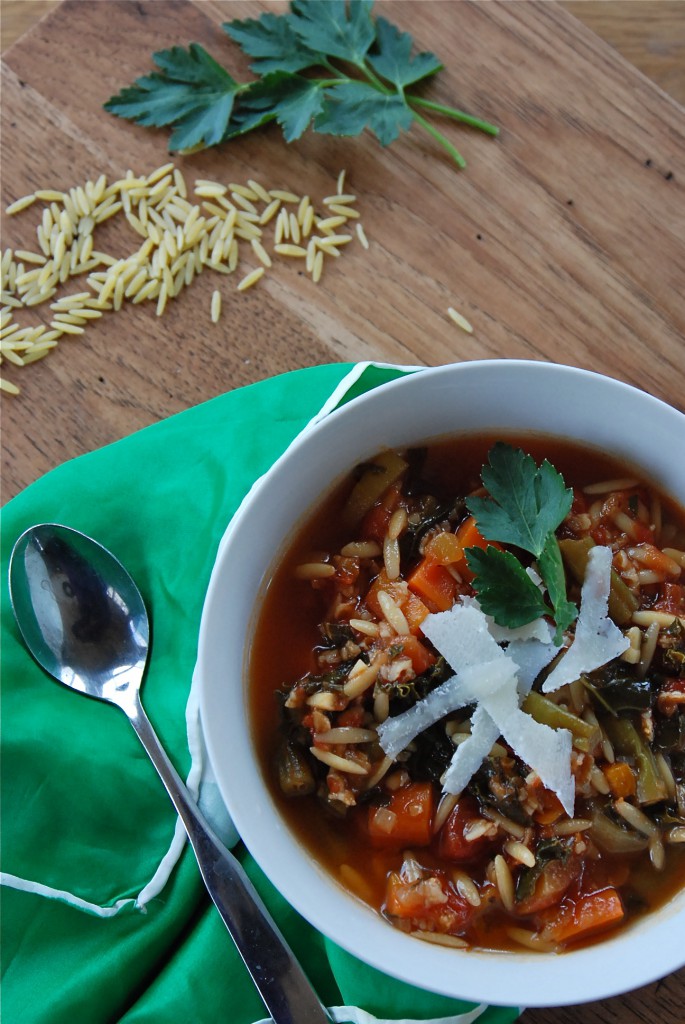
Soup has but a few simple secrets to making it shine, such as taking some time to caramelize the vegetables to form a flavor base, a good broth or stock to add more depth and a shot of love, really, to not rush the process. But good soup really starts from need. Or craving and desire.
I used to not be all that good at making soup, mostly because I just didn’t understand why a recipe that looked so simple could often turn out so darn wrong. I wanted depth, a rich flavor that penetrated the spoon and it’s contents, making it something so much more than broth and vegetables. All I really needed was a bit of patience, a lot of practice and tad more salt. Don’t be afraid of a shake of salt over that simmering pot, as it is the one ingredient that can transform a simple pot of soup to one that shimmers it’s warmth right down to your toes.
This Minestrone soup, as all Minestrone soups go, really has no clear outline, no real etymology. It creates itself for the most part, out of what you have on hand, and what you like in your soup. Or, like me on this particular cold January night, it leapt from under my hands out of sheer need. I couldn’t get warm, couldn’t shake a chill that had settled in my core like a wicked internal frost. Somehow, this chill and it’s accompanying rattle in my brain sounded like it was saying, over and over “Make Minestrone!” and I moved, on automatic it seemed, from fridge to stove to cupboard, seeking and searching ingredients. There were the green beans languishing in the drawer and in dire straits, there was Pomi tomatoes (my favorite packaged tomato- so amazingly fresh and flavorful) and there were thick, deeply orange carrots, fat tear-jerking onions, a partial box of orzo, a few zucchini beginning to look slightly sorry for themselves, just enough kale, a bounty of fresh oregano and parsley. And while the fragrance filled the house, and the soup simmered it’s coherent and rhythmic blup-blup-blup on the stove, a quick search for dunking material in the freezer yielded a container of croutons, spiked with herbs and olive oil, that I’d made from a loaf of stale semolina bread. Did I mention another key ingredient to perfect soup just might be a touch of serendipity?
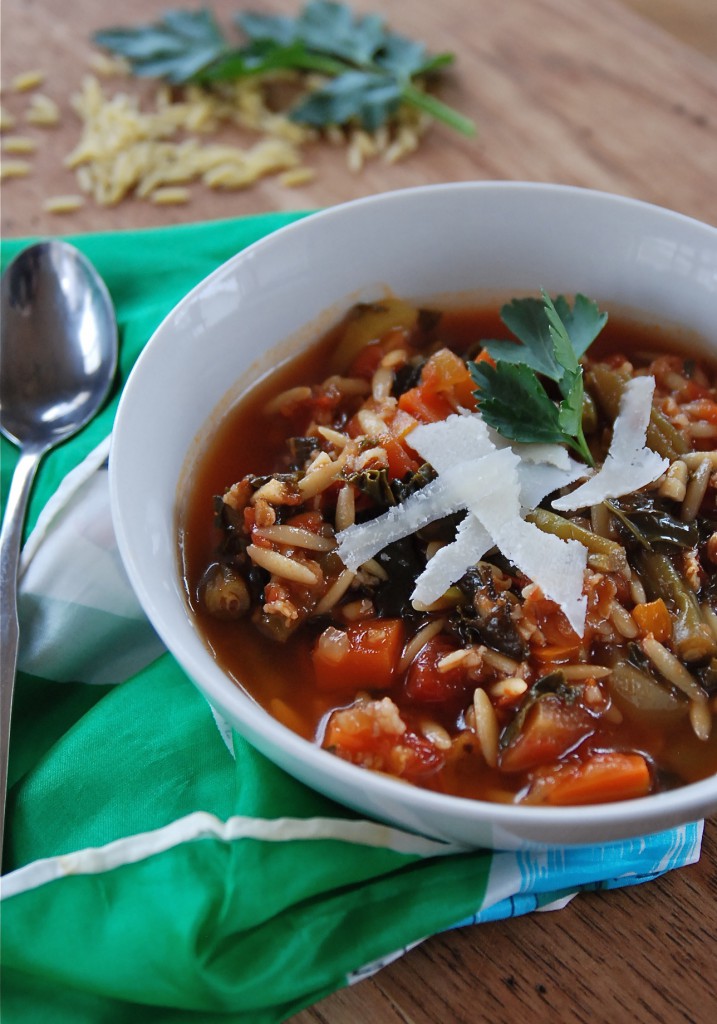
Minestrone requires little of the hard and fast rules; you add what you’ve got, really. What is in season, what is available, what it is you like. It needs a good tomato-y base, without a doubt. But beyond that, it lives for your interpretation. Thick or thin, meat or not, one, two or three vegetables or a whole produce aisle of them, pasta, legumes or rice- it’s all up to you. This version that served to warm my very cold, rattling bones on that damp, chilly night made light of too many singular remnants from the fridge; bits and pieces of plans that maybe fell through or were forgotten, or the one too many of any vegetable that hadn’t been used up yet. It had oceans of freshly chopped oregano and parsley tossed casually over it all, with thick shavings of sharp parm-reggiano. It was like planning a party at the last moment, not so confident of how it will all turn out and right in the middle of it, you realize that everyone in attendance has created an impeccable presence that elevates the whole of it to something utterly sublime. Well, that was my Minestrone that night; a delicious party in a stockpot, gathered with fingers crossed. My intensely perfect Minestrone.
Rounding it all out were the crunchy croutons, oiled, herbed and perfect for soaking up the broth. Beyond that, my perfect soup needed little else but a spoon, a quiet table with two smiling handsome faces, because no day in my life is complete without it ending right there, with them. The darkness settles, chasing out the light with violet and gold tones. The first spoonful I lift easily helps me cross the threshold from day to night, pushing the cold away, warmly coursing through me. There is a sigh, with half-closed eyes, a look and a feel that says “Perfect. This is just what I need.”
Kate’s Minestrone
1 large onion, diced
3 carrots, peeled and diced
3 celery stalks, with leaves, diced
4 cloves garlic, minced (adjust to taste, I am a garlic lover)
2 small zucchini, peeled and diced
1/2# fresh green beans, cut to 1/2″ pieces
1 bunch fresh kale, rough stems removed and chopped (sub chard, collards, or spinach)
1 32-oz pkg Pomi Tomatoes (use equivalent of your choice)
1/2 c. Orzo pasta (use small pasta of choice)
1/4 c. bulgur (optional, but I like the heft and nutrition it adds)
1/4 c. fresh chopped parsley and oregano (basil and thyme are also good)
Parm-Reggiano shavings
In a large stockpot, heat a small amount of oil and add the onions. Cook over medium heat, stirring occasionally, for about 5 minutes, or until the onions are opaque. Add the carrots, celery and green beans and cook, stirring, until the vegetables begin to brown a little, maybe 10-15 minutes. Moderate the heat to prevent them from scorching.
Add the garlic and a pinch of kosher salt. Stir to incorporate and cook for a few minutes until it’s wonderfully fragrant. Add the zucchini and the tomatoes and a quart of broth or water. Bring to a simmer and cook until the vegetables are tender enough to pierce with a fork, but not completely soft.
Add the kale, the pasta and the bulgur, if using. Depending on what pasta shape you use, cook until the pasta is al dente. Taste the soup and season with salt and pepper. Make sure the pasta is cooked, but also remember that it will continue to absorb liquid as the soup sits.
Ladle soup into bowls and top with a sprinkling of the fresh herbs and some shavings of cheese. Serve with a good bread, if desired.
RECIPE NOTES: This soup is wide open to interpretation, and can be modified in a multitude of different ways. Brown some good sausage and use the fat rendered to cook the vegetables for an added punch of flavor. This was a favorite way to make this soup back in my meat eating days.
Legumes can be added to this as well, and most Minestrone soups have them. Use a good quality white bean, such as Great Northern or Cannellini. Chickpeas would also be a good option.
As is the case with most soups, it develops a lot of flavor as it sits overnight in the fridge, but it will also absorb a lot of liquid in to the pasta and the bulgur (if you use the bulgur). Adding a little water to the soup before reheating will help loosen it.
Linking up to Soupapalooza 2012!!
“Come join SoupaPalooza at TidyMom and Dine and Dish; sponsored by KitchenAid, Red Star Yeast and Le Creuset”
February 5th, 2012
| 4 Comments »
This post could also be aptly titled “The end of searching for the perfect banana bread” but that just seemed too long and a bit too final. I should never think I’ve ‘arrived’ at any destination, be it a quest for knowledge, a higher level of health and well-being or never-ending search for perfect banana bread, as somewhere out there, a recipe may exist that could bring this loaf to shame, but for now, I’m sticking with what I’ve got.
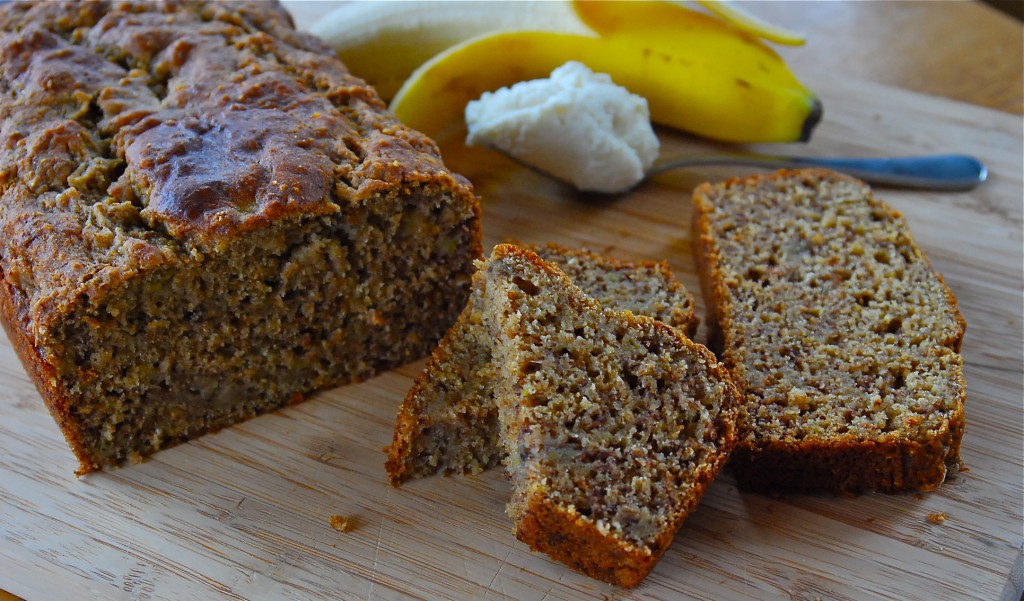
I grew up eating banana bread, from the earliest memories that I have. My Mom made it almost weekly, in fact, I’m pretty sure she bought way more bananas than she needed just so she’d have an excuse. She put walnuts in it, which I despised, so these days, my banana bread is always without nuts. When I got old enough to make my own banana bread, I turned to her tried and true recipe from my youth, and as an adult, I found it sorely lacking, so I moved on. And on. And on.
The goal that I’ve strived for, over recipes and time and growing older, was pure banana bread bliss and perfection that existed as a mental taste somewhere in my mind. And with the first bite of this grain-studded loaf, rich with banana flavor, I about leapt in the air with delight, shouting ‘Eureka!! I have found it!’ while my son chuckled in delight at my antics, he himself wide-eyed and excited over the taste of his piece. This IS pure banana bread delight, and I don’t say that lightly. Folks, I have made and eaten A LOT of banana breads in my lifetime, as I sought out that elusive fine balance of moist and tender crumb, ultimate banana taste and now, a higher level of health than a loaf crushing the scales with sugar and fat. After researching low-fat, and healthier banana bread options for over an hour, I settled on one recipe that gave me a pretty good start, and then started tweaking it to my liking.
I think my biggest disappointment with banana bread has always been that it just doesn’t have as much banana flavor as I want. I add more banana to any number of recipes, and I get mushy bread that turns soggy after a few days, so clearly, without some changes to the base, that’s not a workable option. And I needed a substantial heft other than what flour and leavening can offer in order to stand against that large dose of delicious bananas. When making muffins, I’ve turned to the use of cereals and grains to add more heft, and to make them a bit more nutritious. When faced with adjusting a banana bread recipe in the same way, that’s where I went as well. This recipe has whole rolled oats, All-Bran cereal and a commercial 10-grain cereal as a majority of the dry base. Cutting back on the use of eggs, I added some ground flaxseed for binder (you could also use unsweetened applesauce for this as well). The ricotta cheese, along with a small amount of milk, provides a richness in the texture that’s particularly pleasing to the mouth. The sugar was another matter; I took a gamble, using only a mere half cup in a recipe that makes two loaves. Most tea-bread recipes that I come across have, at least in my opinion, way, way too much sugar, and this amount was perfect. The end result is a bread without the teeth clenching sweetness, so the rich banana flavor just shines through. The cereal and grain base makes the texture nubbly and firm, and helps it retain a lot of moisture. Best of all, the loaves are simply packed with banana flavor.
A lot of this was pure kitchen chemistry, mixed with a lifetime of learning why the recipes I tried were so disappointing. After so many experiments, it’s nice to finally land on something that lifts your heart and elevates your taste-buds, all the while being reasonably healthy enough to enjoy without much guilt.
If you’re like me, when bananas get past the point of consumption in your house, they get tossed in the freezer to await a baking urge, and this recipe is perfect for when you’ve gotten a large stockpile of them.
Whole Grain Banana Ricotta Bread
Yield: Two loaves. It can easily be cut in half.
Preheat the oven to 350°. Spray two 9×5 standard loaf pans with cooking spray.
In a large bowl, mix together the following:
6 large, very ripe bananas, mashed
3/4 c. ricotta cheese
1/3 c. milk of choice
1/2 c. sugar
3 T. grape-seed oil (or other neutral flavored oil)
1 t. pure vanilla extract
1 egg
2 T. ground flaxseed
1/2 c. whole rolled oats
1/2 c. All-Bran cereal
1/2 c. commercial 10-grain cereal, such as Bob’s Red Mill (sub 7-Grain, or 5-Grain if you can only find those)
Whisk this until well blended and allow to sit for about 15 minutes to soften the grains.
In a large measuring cup, combine the following:
2 c. whole wheat flour
1 c. unbleached AP flour
1 t. sea salt
1-1/2 t. baking soda
2 t. baking powder
Add the dry ingredients to the bowl with the banana mixture, and with a rubber spatula, gently fold them together until all the dry ingredients are incorporated. Be careful not to overmix. The batter will be very thick.
Divide the batter between the two loaf pans and smooth the top. Drop the pans on the counter a few times to settle the batter and release any air pockets. Bake for 50-60 minutes, or until a toothpick inserted in the center comes out clean. Allow loaves to cool in pan for up to a half hour before turning them out to cool completely on a rack.
RECIPE NOTES: I use All-Bran cereal a lot in baking, and it keeps a long time in your cupboard. Bob’s Red Mill 10-grain cereal is not only a delicious breakfast cereal, but it’s wonderful for breads too, and I’ve also used it in muffins. I keep it in a plastic bag in the freezer and it lasts indefinitely. I also keep a baggie of ground flaxseed in the freezer.
If all you have on hand is whole rolled oats, this recipe would work just fine to use those in the full amount.
If you wish to cut the recipe in half, don’t use the flaxseed, as it acts as a second ‘egg’.
January 31st, 2012
| 4 Comments »
Previously in this space, we talked about mushrooms. Specifically, we talked about my quick and decisive learning curve that led me to an all-out lustrous affair with fungus.
Today, it’s all about Beets.
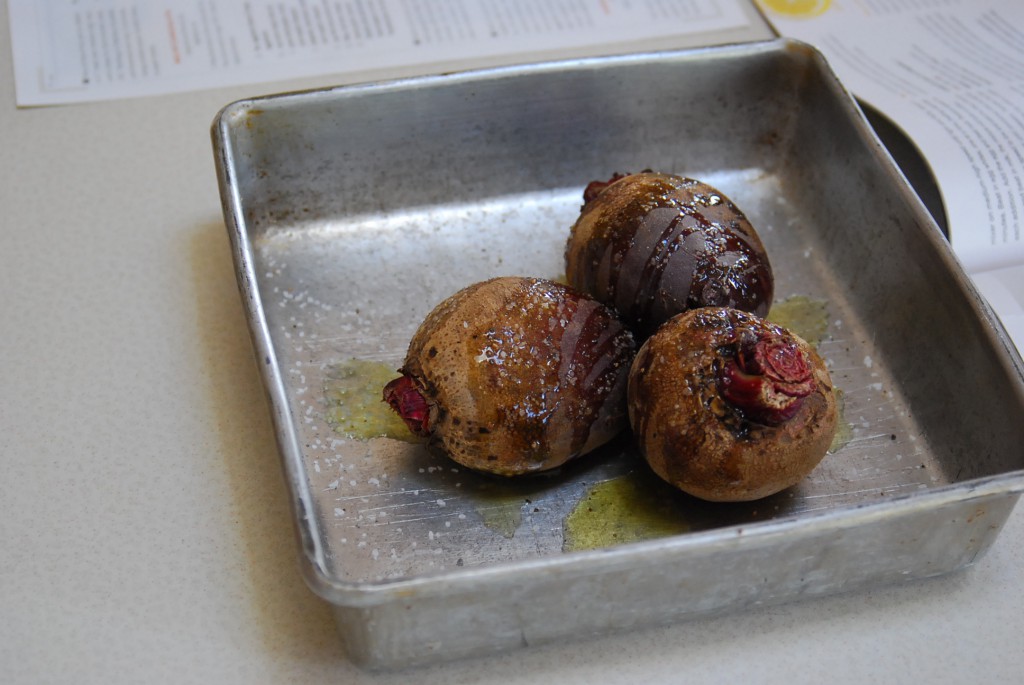
Beets and I had a torrid love affair back in 2009; it was then that I discovered the merits of this earthy root vegetable, one that turns tender and appealing from a long stretch in a hot oven; that it’s earthiness and deep, dark flavor isn’t so overpowering when paired with any number of other ingredients, and most specifically, that the nutrients in this little orb are well worth an incorporation to one’s regular eating. The greens also made their way in to my heart, one of the first to do so, and I believe they were responsible for me learning to love all things dark green and leafy.
Beets have a spectacular nutrient profile, primarily being a superb source of anti-oxidants, with anti-inflammatory and detoxification properties as well. Beets are in the same Chenopod family as spinach, chard and, surprisingly, quinoa. And while they contain an incredible amount of anti-oxidants, it’s the specific ones in beets- lutein and zeaxanthin- that make these vegetables stand out with their nutritional defense for your well-being. Lutein is especially beneficial for eye health, and the anti-oxidant mix in Beets is highly supportive of the nervous system. The anti-inflammatory properties of Beets also support heart health, and can help balance inflammation brought on by Type-2 Diabetes.
But even with all that, many people can’t get past the taste of Beets. They are dark and earthy, and quite honestly, I struggled with them at first, but I discovered that the lovely gold Beets are far less heavy tasting than their red cousins. Once I was able to enjoy the gold, I tried several recipes with the red and found a lot to enjoy about them as well.
Then, along came this recipe, pairing mellow and tender roasted beets with garlic studded mashed potato in a classic Skordalia. One bite and I was in love. With Beets. Again. Oh the glory…..
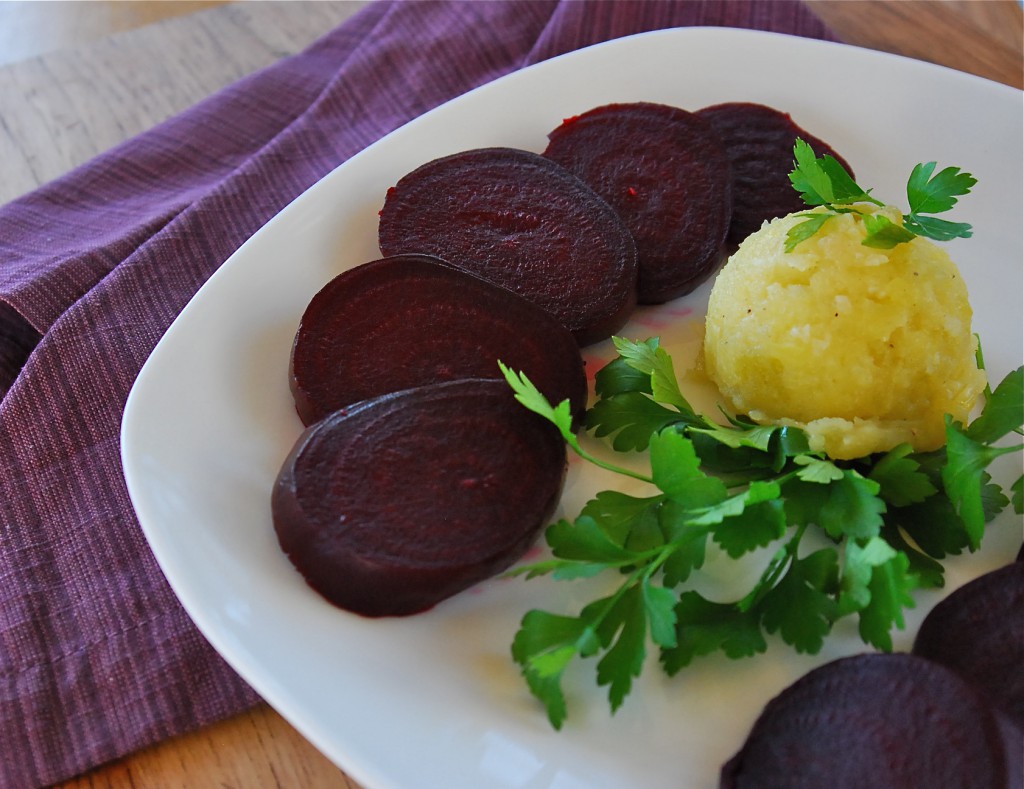
Served warm, with toasted pita bread on the side, this simple, non-fussy dish was rich with flavor and texture. The soft, fragrant potato mix, studded with garlic and thickened with a swirl of a soft, fruited olive oil lends a beautiful contrast to the hearty and tender roasted beets. I would have never imagined that the two of these foods together, both so simple and humble, would be so perfect.
Roasted Beets with Skordalia
4 medium red beets (about 1 1/2 lbs.) trimmed and cleaned
10 tbsp. extra-virgin olive oil
Kosher salt and freshly ground black pepper, to taste
1⁄4 cup finely ground toasted walnuts
1 tbsp. red wine vinegar
6 cloves garlic, smashed and minced into a paste (I sauteed the garlic in some of the olive oil before adding it to the potato for a more mellow garlic flavor)
2 medium russet potatoes,
peeled and cut into 1″ squares and boiled until tender
Heat oven to 425°. Put beets in an 8″ x 8″ baking dish and drizzle with 2 tbsp. oil. Season with salt and pepper and pour in 1 cup water. Cover pan tightly with foil and crimp edges to form a seal. Bake beets until a knife inserted into beet slides easily into the center, about 1 hour. Transfer pan to a rack, carefully uncover, and let cool for 30 minutes. Peel beets and cut into 1″–2″ pieces; set aside.
Put walnuts, vinegar, garlic, and potatoes into a medium bowl and mash potatoes until smooth. Vigorously stir in remaining oil and season with salt and pepper. Transfer beets to plates and serve with some of the skordalia spread on the side.
Recipe posted in it’s entirety from the original source in Saveur magazine, issue #131.
January 27th, 2012
| 4 Comments »
January is drawing to a close and we’ve only just now received the first good snowfall to completely cover the landscape. And with only one brief cold snap, where temperatures dropped below zero for a day or two, it really just hasn’t felt much like winter at all. Still, the calendar doesn’t lie, the light still falls off before the dinner hour -although it gets later and later every day!!- and the hum of an oven, concealing something aromatic and delicious is still welcomed in any Minnesota home.
Lemon is everywhere right now. Those bright yellow orbs are certainly popular in the wintertime, bursting forth with that incredible fresh scent. Lemon is like sunshine, and not just from the sunny yellow color; that spritz of luscious lemony aroma that bursts from the rind when you cut into it is a wonderful tonic to the drab and gray of a winter day. I even feel sunnier eating lemon, like the light rays are just pouring through me. And citrus fruits are coming to the cold, lifeless mid-section of the country in all forms; gigantic globes of grapefruit, sunny tangerines, adorable little kumquats and key limes plus endless lemons.
I love to bake with lemon anything, and I particularly love the fresh zest paired with blueberries. But I have to admit that a lemon pound cake can make my knees weak. There is something about that tart bite, and the dense moist crumb that gets me, that makes it irresistible. But I’m not such a huge fan of the calories in pound cake, so finding a recipe that makes a lighter and less caloric version made me eager to try it out. But I had to ask myself…. would this even be worth it? We’ve all had those experiences of finding a less decadent way of baking a prized cake that simply falls flat. I couldn’t stand to be faced with a lemon cake that left me wanting more.
Needless to say, I was not at all disappointed.
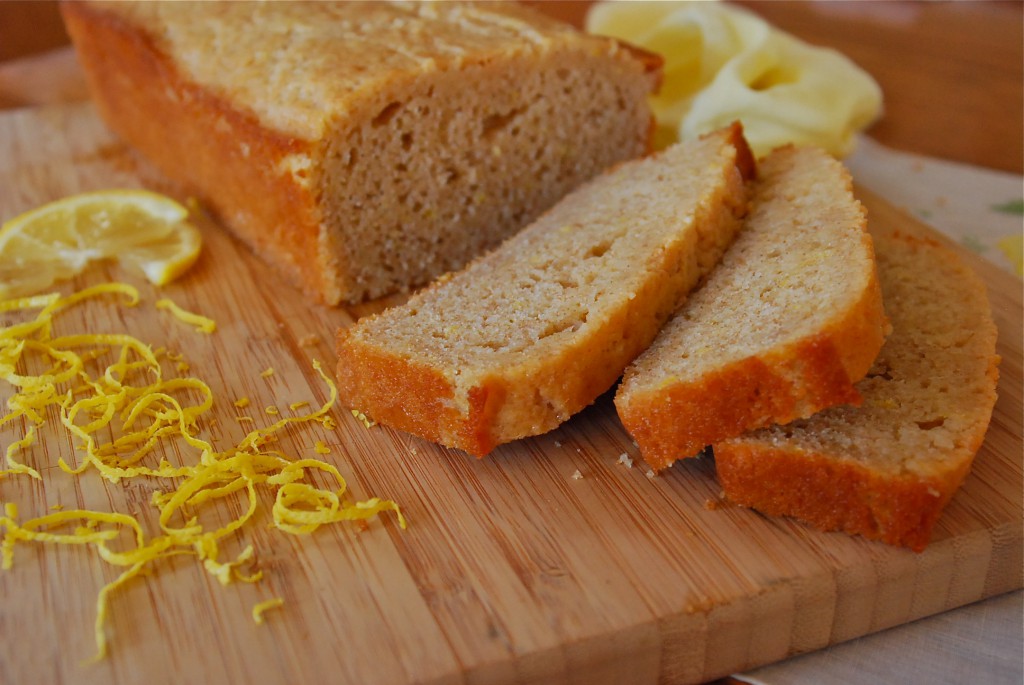
If you didn’t know that this cake wasn’t made with a ton of butter and sugar, you might not realize it at all. It still has that gloriously dense texture that’s rich and satisfying. It still shouts “LEMON!!” with every bite. It satisfies and satiates and makes for a luxurious treat that doesn’t leave you feeling too guilty. There’s a ‘just tart enough’ glaze brushed over the top of it to add even more of that lovely mouth-puckering taste, making the top of the cake nice and soft too, something I love about a good teacake.
The bright and sunny winter day even made the photos look like they were bathed in lemony light.
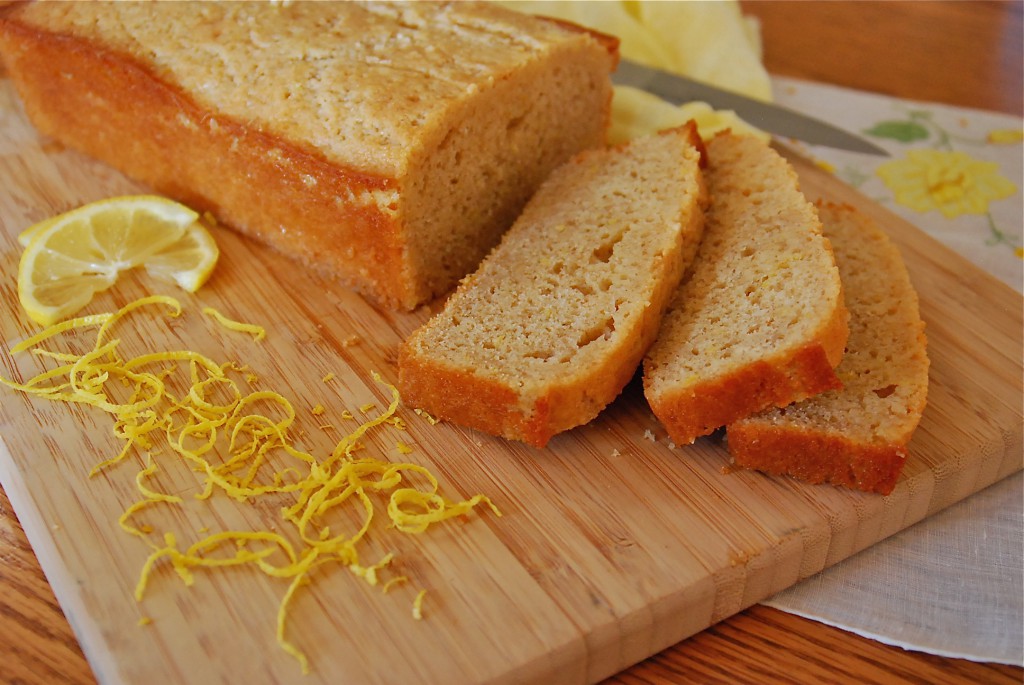
Lemon Pound Cake
- 1 cup whole-wheat pastry flour or white whole-wheat flour
- 3/4 cup all-purpose flour
- 2 teaspoons baking powder
- 1/4 teaspoon salt
- 3 large lemons, divided
- 1 1/4 cups sugar, divided
- 3 ounces reduced-fat cream cheese (Neufchâtel), at room temperature
- 2 tablespoons butter, at room temperature
- 3 large egg whites, at room temperature (see Tips)
- 1 large egg, at room temperature
- 1/2 cup reduced-fat milk
Preheat oven to 350°F. Coat a 9-by-5-inch (or similar-size) loaf pan with cooking spray; dust with flour and tap out any excess.Sift whole-wheat flour, all-purpose flour, baking powder and salt together into a medium bowl.
Finely grate 2 tablespoons zest from 2 of the lemons; set the lemons aside. Beat 3/4 cup sugar, cream cheese, butter and the zest in a large bowl with an electric mixer on medium-high speed until light and fluffy, about 2 minutes. Beat in egg whites, one at a time, beating well after each addition. Add the egg and beat well. Reduce speed to medium and beat in milk; the mixture will look curdled.
Reduce the mixer speed to low and add the flour mixture in 2 batches, beating just until combined and scraping down the sides of the bowl as necessary. Transfer the batter to the prepared pan and smooth the top with a rubber spatula.
Bake the cake until a wooden skewer inserted in the center comes out clean, 45 to 50 minutes. Cool in the pan on a wire rack for 15 minutes. Run a knife around the sides and turn the cake out onto the rack.
While the cake is cooling, squeeze 5 tablespoons juice from the zested lemons. Trim the ends off the remaining whole lemon and very thinly slice; discard any seeds. Heat the lemon juice and remaining 1/2 cup sugar in a small nonstick skillet over medium heat, stirring until the sugar is dissolved. Add the lemon slices and cook, stirring frequently, until softened, about 5 minutes. Reduce heat to maintain a simmer. Use a fork to transfer the lemon slices to a bowl. Continue simmering the syrup until slightly thickened and beginning to turn golden yellow, 2 to 4 minutes
Set the rack over a rimmed baking sheet. Poke holes all over the top of the warm cake with a wooden skewer, 1 1/2 to 2 inches deep. Spoon the glaze over the cake, poking more holes if the glaze does not sink in. Arrange the lemon slices on top. Let the cake cool completely before slicing.
Recipe Notes: I made my cake with the glaze, and not the candied lemon slices. I tried, but they fell apart in the syrup and looked strange so I didn’t put them on the cake. The glaze was good, but I think the cake doesn’t really need it either.
Recipe from Eating Well magazine, posted in original form.
January 24th, 2012
| Comments Off on call of the wild
January 23rd, yesterday, I strapped on my cross-country skis for the first time this winter.

This Winter, waiting for snow cover deep enough to kick through has nearly killed me in anticipation, especially given that last year I was out almost every week between late November to well through March. Every snowfall that came our way found me holding my breath, anxiously awaiting the perfect amount that never came.
Certain activities are just part of who I am. Cooking, for one. But this, the strapping on of tiny thin skis, grasping the little poles and facing an open path of fresh snow, wind in the trees and clouds scuttling overhead is also a part of me that goes back to moments in childhood that seared to my brain like fire. I don’t even know how old I was the first time I put on the skinny skis. But I was a kid, and our school class went to a golf course one winter day, lush with a endless expanse of unbroken snow and we all were given those skis, the long poles and funny shoes and we set out over the empty golf course, where it clicked within me.
And in repeated winters, over growing years, those endless snows spread out in front of me as I faced them, tall poles in hand, face to the wind. Then at some point, they just stopped. But the call within me never left and finally several winters ago, I urged Mike to get ski packages and join me on the trails. It was one of the best decisions we’ve ever made.
Because the first time I headed along a trail, pushing every muscle from shoulder to ankle over the snow, I felt that thrill again. I felt the flood of oxygen to every working muscle. I felt the quiet cold air and saw those dancing clouds. I felt alive again, working with muscles that still held the perfect memory of how this was done, even though it had to be more than 20 years since we’d moved in this way. I marveled at a body that remembered, when I had nearly forgotten; marveled at muscles that snapped into recall, pulling memory from some long ago moment in time. And I wondered why I’d stopped.
There is a tiny little park near our house; hardly a spot on a map but it’s flat, and just large enough to make for a perfect workout. I carve a trail around the perimeter, and go four, five six, sometimes eight laps or more around that park. It’s enough to make my lungs pump fiercely. It’s enough to drench me in sweat. It’s plenty, and it’s close and it’s 45 minutes to an hour of intense cardio work. If I can do this a few times a week, it’s all I could ever ask for from Winter.
The snow flies, and I hear the siren call from the trails. Yesterday was that call, and barely a half hour after I was home from work, I faced that empty park, with a wicked cold Easterly wind on my back and stepped in to my skinny skis. The first path over the snow cuts my trail, and every lap gets easier as I go. My lungs engage, my muscles warm, the wind doesn’t seem so bitter and Winter doesn’t seem all that long anymore. It’s just me and the snow.
It’s Just Write Tuesday, Version 19.0.

January 18th, 2012
| 7 Comments »
I did not grow up loving mushrooms. I didn’t even like them, not one little bit. But I surely can’t blame myself, for my only exposure to them as a child of the ’70’s was from a can. And I can’t imagine anything more disgusting than canned mushrooms to a kid. No wonder I was never a fan of the fungus.
As I got older, I allowed a bit of mushroom to pass my lips; I loved them sauteed on a burger, or with a grilled steak. Provided I could have something in my mouth with them, they became only slightly more palatable to me, but I still struggled with texture, and that rich, loamy earthiness to them. Cover them with good red wine, and sauté them in copious amounts of butter and it was ok. Just ok though. Still, they weren’t on my favorites list by any means.
Then I had an epiphany, last summer. A major turning point in my culinary taste occurred at one of the wonderful events I attended last year with the Minnesota Food Bloggers group. It was at Cafe Levain in Minneapolis, and Chef Adam Vickerman created grilled portabella mushrooms, richly glazed in balsamic vinegar. I took a few tentative bites of them and my eyes were opened. I was re-born, re-newed and suddenly, all-out crazy for mushrooms. And to Adam’s credit, I’ve been slightly obsessed, and eating them weekly, ever since.
Mushrooms fit well into a healthy eating plan, and that makes them far more desirable given my all-enveloping obsession. Mushrooms have been revered in Eastern culture for thousands of years for their nutritional properties. Mushrooms are low in calories, fat-free, cholesterol-free and very low in sodium, yet they provide important nutrients, including minerals like selenium, potassium, copper, and vitamins such as riboflavin, niacin (the all important B vitamins) and vitamin D. And then there’s beta-glucans- something I’d never heard of before, and according to Mushroom Info:
“Beta-glucans, found in numerous mushroom species, have shown marked immunity-stimulating effects, contribute to resistance against allergies and may also participate in physiological processes related to the metabolism of fats and sugars in the human body. The beta-glucans contained in oyster, shiitake and split gill mushrooms are considered to be the most effective.”
So I can feel good about the amount of mushrooms passing my lips, and I like that. I can incorporate mushrooms in to just about any dish, but I hadn’t really done much with them in a soup so it was fun to come across this amazing Wild Rice & Mushroom soup recipe on The Kitchn, even better that I stumbled upon it as the coldest air of the month landed on Minnesota, making for a perfect backdrop to a steaming bowl of this thick and hearty soup.
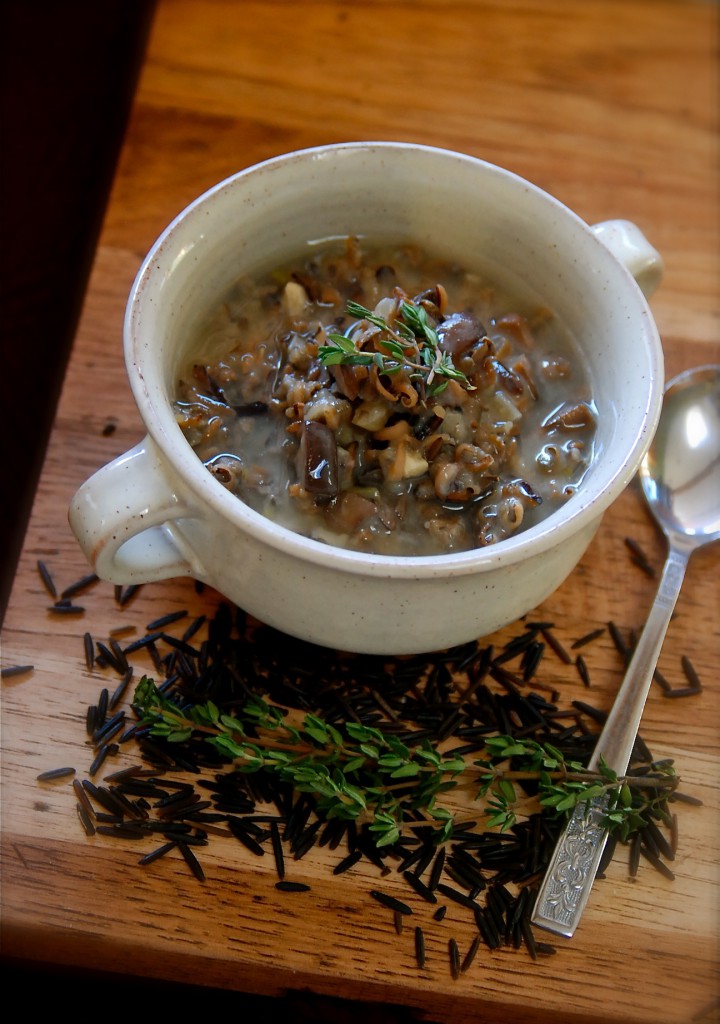
If you love a good wild rice soup with chicken, or turkey, you’ll love this lush recipe, which deeply browns mushrooms to develop their rich flavor. A bath of white wine and some good vegetable broth helps round out the simple but complex flavors. Wild rice was another food item I had to learn how to love, but thankfully, this wasn’t that difficult, and we’ve been enjoying wild rice soups for years. This one, with it deep earthy flavors and thick broth will be on repeat now. We all loved it, and soup is such a good leftover item to have on hand.
Wild Rice and Mushroom Soup
1 c. wild rice, washed
1 large onion, diced
4 celery stalks, diced (I love the flavor of the leaves and used a lot of those)
2 cloves garlic, minced
1 pound of mushrooms, rough chopped (I used baby portabella, but adding some porcini or oyster would be delicious)
1 t. fresh thyme
3 T. AP flour
1 c. white wine (I use pinot grigio in cooking. DO NOT use cooking wine from the grocer. Ugh)
1 Bay leaf
1-2 cheese rinds, optional
2 t. fresh rosemary, chopped
1 c. whole milk or heavy cream (I used a lot less, but adjust according to your taste)
1 T. cider vinegar
Salt and fresh ground pepper
Bring a pot of water to a boil and add the rice with 1 teaspoon of salt. Reduce to a simmer and cook for 40-50 minutes, or until the rice has burst open and is soft. You can leave it a bit underdone if you wish, and cook it to taste with the final soup. Drain the rice, reserving the cooking water to use in the soup if you wish. (I did this. Wow. What a flavor)
Meanwhile, heat a teaspoon of oil in a large dutch oven or stock pot over medium-high heat. Add the onions and celery with a pinch of salt and cook until softened and translucent, about 5-7 minutes. Turn the heat down to medium and add the mushrooms and another pinch of salt. Cook until the mushrooms have released their liquid and start to brown; this should take anywhere from 20-40 minutes depending on the size of your stock pot. I cooked them to a really deep brown. Don’t skip this step as this is where a lot of the flavor of your soup will come from.
Once they are nicely browned, add the garlic and thyme and cook for about a minute. Sprinkle the flour over the vegetables and stir to coat. Stir the flour until the mixture becomes sticky, and no visible dry flour remains. Increase the heat to medium-high and add the white wine. Stir and scrape the bottom of the pan, simmering until the wine has reduced and thickened.
Add the bay leaf, cheese rinds (if using) and stock or the cooking water from the rice. Bring to a boil, then reduce and simmer for about 20 minutes to blend the flavors. Add the rosemary, milk or cream and the wild rice, cooking for another 10-15 minutes, or until the soup has thickened to your liking. Stir in the cider vinegar, season with salt and pepper to taste.
Original recipe from The Kitchn, by Emma Christenson.
***This soup will thicken as it stands, and the rice absorbs more of the liquid. I’ve found that when re-heating it the next day, it tastes best to scoop out a serving and add water to loosen it up.
Linking up to Soupapalooza 2012!!
“Come join SoupaPalooza at TidyMom and Dine and Dishsponsored by KitchenAid, Red Star Yeast and Le Creuset”
January 17th, 2012
| 7 Comments »
See anything new???
A new year is a good time for change. And a good time for a re-design, whether with your life, or with your blog. I’ve been swerving back and forth over the past year on what the focus of this blog really is, and it’s pretty clear that it’s been changing a lot. It’s gone from strictly recipe focused to opening the door, just a glimpse, in to what goes on in my head, my heart and my life. So it’s really not a food blog any longer. But yet, it still is.
My on-line friend Lisa posted something today that blew me backwards a bit. And when I righted myself, and read it again and again, it sank it’s teeth in to me and held tight. She’s gotten so far away from where her blog had originated that she contemplated shutting it down. {{and haven’t we ALL been there, at least once or twice??}} But then a friend of hers said “This space has become more of a savings account for things you like, rather than purely recipes as it was.”
Well, that’s what blew me backwards because it was exactly what my mind was trying to find in regards to this space of mine. So, in addition to a new, fresh and modern look, with some more muted color schemes, I also changed the tagline of the blog. See it over there on the upper right side? It used to say ‘the evocative fare and delicious stories of a passionate cook’.
Now it just says what this treasured space of mine has become: a blog of food and life. Because when it comes down to it, there is no life without good food. And there is no good food without a richly varied life.
I’ll be updating the Recipe Index a bit more too, but to start, I wiped it clean of really old posts, with recipes that are no longer relevant, and photos that made me cringe. If you go searching my site for a recipe, I want it to be the best one I can offer as that’s the least I can do. And if you ever come across a dead link, please let me know and I’ll set it right again.
We’ve also got icons for my Facebook page if you wish to keep updated on my posts that way, and another one so you can come and hang out with me on Twitter.
Ready for another spectacular year?? I am!!
|


















